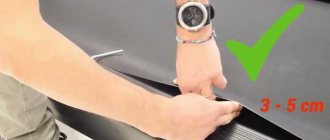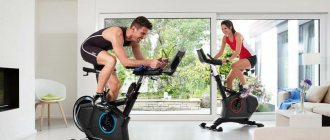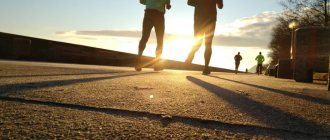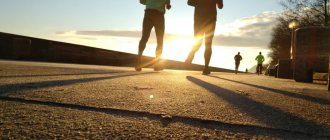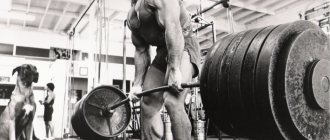Poster for the film “Red Start”.
Alexey Republicommando translated for Zozhnik a huge, fresh review of scientific literature (51 works, list attached) on the benefits and harms of aerobic training volume.
Almost everyone knows that physical activity is beneficial. A wealth of scientific evidence supports the therapeutic effects of exercise on quality of life, cardiovascular health, and longevity.
Why is it dangerous to run too much?
However, many people mistakenly believe that the more, the better. Excessive cardio training volume can have a negative impact on cardiovascular health. Ultramarathon running may result in myocardial damage , as evidenced by elevated levels of troponin and brain natriuretic peptide.
Additionally, sudden cardiac arrest occurs more frequently in marathons and triathlons than in shorter distance events. Older marathon runners often exhibit abnormal cardiac remodeling (structural changes) with an increased risk of myocardial fibrosis and ischemic calcification.
Chronic excessive exercise is associated with an increased risk of atrial fibrillation (AF).
Caricature “Running from a Heart Attack”, Ruslan Dolzhenets.
How much running is good and how much is harmful?
The optimal dose of cardio is likely to vary between individuals and is not well established at this time. So far, current research indicates that 2.5 to 5 hours of moderate to vigorous physical activity per week will provide the greatest benefit ;
But >10 hours/week may already reduce these health benefits .
Conversely, a sedentary lifestyle and excess weight, in addition to being causes of premature death and disability, have many adverse consequences, especially for the cardiovascular system (CVS). About half of the adult population in the United States today suffers from some form of CVD [1].
Physical exercise is one of the powerful tools for the prevention of cardiovascular diseases [2], and together with the improvement of the cardiovascular system, the development and severity of coronary heart disease (CHD) is prevented and the risk of other diseases is reduced .
There is such an indicator - MET - “metabolic equivalent of physical activity” (here, for example, you can read more about it). Each additional MET unit reduces all-cause mortality by 30% in untrained individuals (who initially have <5 METs of exercise) [3].
And here’s another serious figure: physically active middle-aged people will live on average 8 years longer than “sedentary” people ; and for patients with diagnosed CVD, cardiac rehabilitation improves prognosis and quality of life [4].
Exercise has a positive effect on almost every aspect of the body and brain, improving physical and mental well-being; staying physically active is one of the best ways to maintain health and increase your life expectancy.
Although the ideal dose of exercise has not yet been determined, it is clear that at least half of Americans do not get the recommended 150 minutes of moderate physical activity per week.
Even light-to-moderate-intensity physical activity for as little as 15 minutes per day , about half the recommended minimum dose, has significant longevity benefits, with the most dramatic risk reductions seen when moving from a completely sedentary to a lightly active lifestyle [7 ]. On the other hand, about 2.5% of American adults over-exercise, thereby exposing themselves to potential detrimental health effects [7].
The topic of the optimal dose of physical activity to ensure the best health and longest life expectancy is actively discussed in the scientific literature. The purpose of this article is to clarify this issue by focusing on the body of accumulated evidence [8-14].
How to breathe correctly while running
Be sure to learn how to inhale and exhale measuredly to avoid side pain.
If you use only your nose, there will immediately be a lack of oxygen, which will exhaust you. In winter, keep an eye on your airways. The following advice will help you avoid problems: you need to touch the roof of your mouth with the tip of your tongue and leave it in that position when you inhale through your mouth. Take in air twice as long as you give it out. Be sure to control the rhythm at first. Over time, you will get used to it, you won’t even have to put in extra effort. You learned how much and how to run per day to lose weight quickly. It is important to choose a specific type that is most suitable for your current condition and corresponds to your desired goal. To keep your body in good shape, you need to exercise regularly.
Cardio effect curve
The optimal dose of physical activity that brings maximum health benefits is still unknown to us [15]. Even 2,500 years ago, Hippocrates taught: “If we could give every person the right amount of food and exercise—not too little and not too much—we would have found the safest path to health.”[7] Even then, scientists understood that a certain range would be optimal for improving well-being and life expectancy; a smaller or larger training volume would reduce the benefits.
Paffenbarger described the relationship between physical activity (walking, climbing stairs, and playing sports) and all-cause mortality using the reflected J curve as early as 1986. The study followed 16,936 Harvard graduates for 16 years and found that moderate exercise reduced risk the most [16].
Since then, numerous large observational studies, collectively covering more than 3 million people, have shown similar results, suggesting that there appears to be an upper threshold at which very high doses of intense exercise appear to be associated with loss. some longevity benefits associated with less extreme doses of intense exercise.
As shown in the graph below, almost all large observations reproduce this reflected J-curve. It shows how the risks of CVD and premature mortality are reduced in a dose-dependent manner until an activity threshold is exceeded, after which the benefits decline. In many studies, this risk reduction is not statistically significant due to the small number of individuals in the “extreme” cohort, yet this association has been repeatedly found; In the largest studies, the reduction in health benefits observed with extremely high doses of exercise remains statistically significant [8].
Each curve is one study. Vertical - risk level, yellow dot - no physical activity, green - optimal level of activity, red - maximum activity.
Where is the best place to study?
Running training for the purpose of losing weight should be as comfortable as possible for a person. The choice of place to run is determined by a person's personal preferences.
On the street
Outdoor running is available to everyone. Park areas and green city alleys, which are away from busy roads and exhaust fumes, are perfect for training. While running, you can not only burn calories, but also enjoy city views, which will have a beneficial effect not only on your physical fitness, but also on the state of your nervous system.
On the track (simulator)
One of the most proven and effective methods for those who are just starting running. The trainer is suitable for both fast walking and other running options. At the same time, it is possible to monitor the speed of movement and seek help and advice from the gym staff. How much time you need to run on a treadmill for noticeable weight loss, a personal trainer will help you determine in each specific case.
Running on a treadmill
On the steps of the stairs in the entrance
Stair running is chosen by those who do not like to exercise outside or in a specialized gym. This workout will be an excellent option for a morning warm-up before the start of a working day. The lesson should begin by moving up and down flights of stairs, gradually moving to more intense movements. Running up the stairs at the entrance is a method of losing weight that is available to everyone, especially those who live in urban areas and cannot find time to visit the gym.
Running up the stairs is the most energy-intensive: in 5 minutes you can burn up to 80 kcal.
At home (running in place)
Running in place is a training option for those who do not want to leave their home. A person should simply run in place, gradually increasing the speed of his movement. During the movement, monitor the position of the knee joints - they need to be raised high.
According to numerous reviews, jogging on the spot at home can serve as a warm-up before strength training. With this type of running, you monitor your movement technique while controlling your breathing.
Arrhythmia: Increases approximately 5-fold in veteran runners
Physical exercise is associated with positive adaptations of CVD, including dilation of all heart chambers, improved function, increased compliance of the cardiac and vascular wall, sinus bradycardia, etc. [17, 18].
However, there is a well-documented increase in the incidence of atrial fibrillation (AF) in endurance athletes. A study of 300 veteran runners (mean age 47.5 years) found a 5-fold increase in the incidence of MA compared with a sedentary control group [19]. Since then, studies have linked MA to more intense training protocols, faster finishing times, and the absolute number of races completed [20].
Long-term endurance training (≥2000 hours and/or ≥20 years of training) is strongly correlated with MA, even in individuals without CVD risk factors [21, 22].
Although individual studies have concluded that the risk of MA may increase by 2- to 10-fold, a recent meta-analysis quantified the risk to be approximately 5-fold [23].
As with many other things, moderate amounts of physical activity prevent MA, while both low and high volumes are associated with an increased risk of developing MA .
Inactive people (<6 METs) have an increased rate of developing MA (compared to more athletic people), and each additional 1 MET is associated with a 7% reduction in the risk of developing MA [24].
In terms of weekly dose of physical activity, even small amounts starting at 5 MET-hours/week appear to reduce the risk of developing MA, with maximum benefit observed at 20 MET-hours/week (see graph below) [25] .
Above 55 MET-hours/week, which is approximately 10 hours of intense physical activity per week, the likelihood of developing MA begins to exceed the risks of the sedentary cohort [25].
Vertical – relative risk of MA, horizontal – volume of physical activity (MET-hour/week), green zone – risk reduction, yellow – approximately equal risks, red – increased risk.
Speed work
A marathon is a test of endurance. But if your goal is not just to run, but to achieve a certain result, you cannot do without speed work. As J. Tracy rightly noted in his 1994 article, “If you are not able to overcome the physical and psychological stress of 800 meters, you can read no further.” This is true. If you don't run fast in training, then where will the speed come from in the marathon?
For speed work, Tracy suggests interval training of 400, 800 and 1600 meters, as well as “running to the limit” or, as it is also called, running to “lactate threshold”. Due to the massive craze for marathon racing, interval training has become very popular. To this day, this is the best way to increase your VO2 max (maximum oxygen consumption).
You can increase your VO2 max by running for 20 minutes or more at your 20 speed. Such training had not been used before, and appeared in plans only in the 90s. Pfitzinger and Douglas wrote in their 2001 paper: “Simply put, we created a training program that stimulates the physiological functions of our body most involved during the marathon - endurance, lactate threshold and VO2max. Therefore, your result at the marathon depends precisely on long and tempo training.”
Another standard exercise—running at marathon pace—has only recently appeared in training plans. In the past, the recommendation was to run 1-mile intervals at this pace. But the idea of running 15-20 km at the estimated speed of a marathon belongs to the 21st century and applies not only to elite runners, but also to amateurs.
Combining all of the above elements and creating a weekly and general marathon preparation plan is an art. And the main thing here is individuality, because there are so many runners, so many plans. Therefore, training programs can be created endlessly, adding new publications to the magazine every season. But there will be no fundamental differences in them.
If you have enough experience and knowledge, you can create your own program using the tables given at the very end of this article. They are based on research by two leading experts based on the results of 1996 and 2003.
Myocardial fibrosis
Myocardial fibrosis is a nonspecific reaction to various cardiac injuries, such as acute myocardial infarction, myocarditis, uncontrolled hypertension and valvular dysfunction. Pathological fibrosis of the heart predisposes to myocardial stiffness, arrhythmia and other adverse consequences [31]. Myocardial fibrosis is best detected by cardiac magnetic resonance imaging (MRI), especially in cases of late gadolinium accumulation (LGA) .
Chronic endurance training overload increases the risk of developing PNH , which has been found in healthy, asymptomatic endurance athletes [31–33]. In addition, PNH is significantly and directly correlated with training experience (in years) and the number of marathons and other ultra-endurance events completed [32, 34].
During strenuous exercise, cardiac output increases approximately 5 times compared to resting values (from 5 L/min to 25 L/min or more), which leads to a disproportionately distributed load on the heart with an increase in the load on the walls by 125% compared to with 4% on the right and left ventricles [35].
Such stress, coupled with a sustained increase in catecholamines and reactive oxygen species, likely causes cumulative injury in the myocardium, ultimately leading to scarring as demonstrated by PNH.
The presence of PNH can be detected by analyzing the number of ultramarathons in which the athlete has taken part, or the severity of coronary artery calcification [34].
Cumulative cardiac MRI data show that PNH occurs in 12% of endurance athletes, which is 8 times higher than the 1.5% rate observed in controls with the minimum dose of physical activity recommended by the WHO (see graph below) [15 ].
Blue column - age endurance athletes, red - total age athletes, orange - sedentary control group, purple - total sedentary control participants. Adapted from Franklin et al. [15]
Review of reviews on the effectiveness of running for weight loss
Analyzing reviews of people who have chosen running as a way to lose weight, we can talk about its effectiveness. Many people note that within the first month they get rid of several kilograms of excess weight without harm to the body. Those who regularly ran and followed all the recommendations observed not only a decrease in the number on the scale, but also a stable state of the nervous system, improved sleep and appetite.
In order to achieve the desired effect, it is necessary not only to exercise regularly, but also to monitor your diet. The secret to losing weight is in a calorie deficit.
The results of jogging, according to real reviews from beginning runners, can be seen after the first month of active training.
Coronary artery calcification
A large body of evidence shows that the amount of calcium in the coronary arteries is an accurate predictor of CVD risk [37]. Paradoxically, although exercise reduces the risk of CAD, too much endurance training appears to significantly increase calcification , bringing us back to the reflected J-curve graph (Figure 4) [38].
Athletes aged 54±8 years have approximately 2 times more atherosclerotic plaques than the control group; these athletes also have a higher degree of calcification [39].
On the vertical line – the degree of calcification of the coronary arteries, on the horizontal – age in years (y) and the number of participants (n).
Association of physical fitness level with the degree of coronary artery calcification. CAC = coronary artery calcification; FAC = functional aerobic capacity. Adapted from Kermott et al. [38]
Overall, studies have confirmed that older endurance athletes have higher rates of coronary calcification than sedentary controls, but they tend to have fewer harmful plaques of mixed calcification and lipid origin [39–41]. Despite this, highly active individuals showed a non-significant trend toward reduced mortality compared with the less active cohort [40].
Acute risks associated with intense exercise
Up to 90% of all sudden cardiac deaths (SCD) associated with exercise occur in recreational rather than competitive athletes , with the incidence of such deaths ranging from 1:22,000 to 1:69,000 in adults, compared with 1:50,000 in youth athletes participating in competitions [43, 44]. The risk of SCD is highest during and immediately after exercise [15]. One study found that the risk of SCD increased short-term by 17-fold during and for 30 minutes after the end of intense exercise.
This risk is much higher in less active people compared to those who exercised more often (relative risk 74 versus 11) [15]. Another study also found that the sedentary cohort had a 25 times higher risk of SCD than those who exercised at least a little [15].
In athletes over 35 years of age, more than 80% of SCD were caused by coronary artery disease (CHD); while among younger athletes (<35 years), the most common causes of SCD were congenital anomalies of the heart muscle, coronary vessels and conduction system [45].
Longer, more physically demanding runs appear to increase the risk of SCD. Data from nearly 11 million long-distance race participants show a higher prevalence of SCD in marathons (1.01/100,000) compared with half marathons (0.27/100,000). Only 29% of victims were able to survive cardiac arrest [46].
It is worth noting that the mortality rate for men was more than 2 times higher than the mortality rate for women (0.98 versus 0.41/100,000) [47].
Triathletes have been reported to have higher rates of SCD than marathon runners. In an analysis of data from 4.7 million triathletes, the incidence of SCD was 1.74/100,000 [48].
As in marathons, the risk for men is 3 times higher than for women (2.40 vs. 0.74/100,000).
Additionally, the risks were 3 times higher for men over 40 years of age compared to younger participants [48].
Acute myocardial infarction (MI) is also more common during or shortly after intense exercise. A number of studies have found that the risk of MI increases 2-10 times within an hour after exercise [15].
Endurance exercise, including marathons and ultramarathons, influences a number of biomarkers of cardiovascular disease. A study of 40 athletes (marathon, triathlon, mountain biking) found that right ventricular ejection fraction decreased by 9% after the race. Regular exposure of the right ventricle to strenuous exercise can cause myocardial necrosis, which ultimately leads to scarring and irreversible remodeling, setting the stage for arrhythmias. The estimated amount of physical activity leading to this effect is thought to be >20 hours per week for >20 years [43].
Additional tips for new runners
We figured out how and how much to run in the morning. But there are other tricks that will help make such workouts more productive and enjoyable:
- start training no earlier than 30 minutes from the moment you wake up;
- take a shower to invigorate yourself;
- drink a glass of water or kefir so as not to run on an empty stomach, but at the same time stimulate metabolic processes (you will have a full breakfast after your workout);
- try to run on dirt roads (this will create an additional shock-absorbing effect);
- do not talk or drink water while running;
- after maximum acceleration, stop and gradually switch to slow running;
- in bad weather conditions (especially ice), cancel the workout;
- equip yourself correctly (you can read more about choosing clothes and shoes for running in this article);
- It’s more fun to run with music, but it’s better to replace a heavy smartphone with a lightweight player;
- It is better to plan your jogging route in advance so that there are fewer cars and more green spaces.

